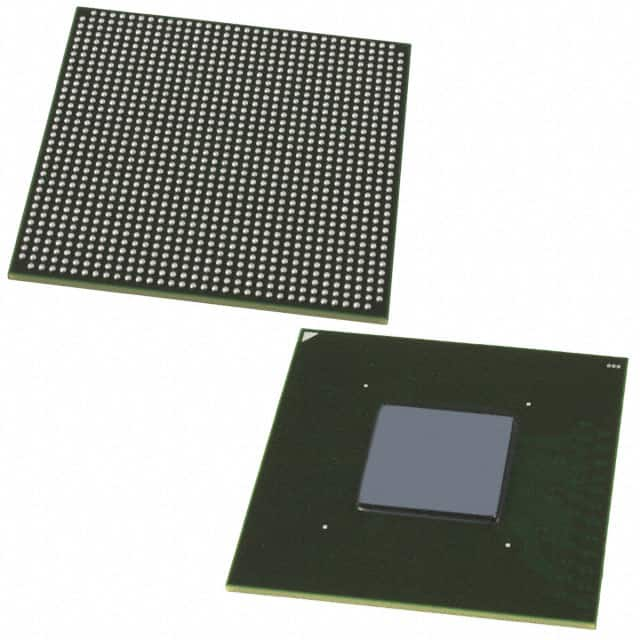Lihat spesifikasi untuk detail produk.

5AGXFA5H4F35I3N
Product Overview
Category
The 5AGXFA5H4F35I3N belongs to the category of Field Programmable Gate Arrays (FPGAs).
Use
FPGAs are integrated circuits that can be programmed and reprogrammed to perform various digital functions. They are widely used in industries such as telecommunications, automotive, aerospace, and consumer electronics.
Characteristics
- High flexibility: FPGAs can be customized to perform specific tasks by configuring the internal logic.
- Parallel processing: FPGAs can execute multiple operations simultaneously, leading to improved performance.
- Reconfigurability: The design of an FPGA can be modified even after it has been deployed, allowing for updates and improvements.
- Low power consumption: FPGAs offer efficient power usage compared to traditional application-specific integrated circuits (ASICs).
Package
The 5AGXFA5H4F35I3N is available in a compact package suitable for surface mount technology (SMT) assembly.
Essence
The essence of the 5AGXFA5H4F35I3N lies in its ability to provide a highly flexible and customizable solution for digital circuit implementation.
Packaging/Quantity
The 5AGXFA5H4F35I3N is typically packaged in trays or reels and is available in various quantities to meet different production requirements.
Specifications
- Logic elements: 115,200
- Embedded memory: 6,144 Kbits
- Maximum user I/O pins: 622
- Clock management resources: PLLs and DLLs
- DSP blocks: 360
- Transceivers: Up to 12.5 Gbps
Detailed Pin Configuration
The detailed pin configuration of the 5AGXFA5H4F35I3N can be found in the product datasheet provided by the manufacturer.
Functional Features
- High-performance processing: The 5AGXFA5H4F35I3N offers fast and efficient execution of complex digital algorithms.
- Flexible I/O interfaces: The FPGA supports a wide range of communication protocols, enabling seamless integration with external devices.
- On-chip memory: The embedded memory blocks provide storage for intermediate data, reducing the need for external memory components.
- Clock management: The built-in PLLs and DLLs allow precise control of clock signals, ensuring synchronization and timing accuracy.
- DSP capabilities: The dedicated DSP blocks enable efficient implementation of signal processing algorithms.
Advantages and Disadvantages
Advantages
- Versatility: FPGAs can be programmed to perform a wide range of tasks, making them suitable for diverse applications.
- Rapid prototyping: FPGAs facilitate quick development cycles by allowing designers to iterate and test their designs rapidly.
- Cost-effective: FPGAs offer cost advantages compared to ASICs for low-to-medium volume production runs.
- Reconfigurability: The ability to modify the design of an FPGA after deployment allows for updates and improvements without hardware changes.
Disadvantages
- Higher power consumption: FPGAs generally consume more power compared to ASICs due to their programmable nature.
- Complexity: Designing for FPGAs requires specialized knowledge and expertise, which may increase development time and costs.
- Limited performance for certain applications: In some cases, ASICs or dedicated processors may offer better performance and efficiency for specific tasks.
Working Principles
FPGAs consist of an array of configurable logic blocks (CLBs) interconnected through programmable routing resources. The CLBs contain look-up tables (LUTs), flip-flops, and other elements that can be configured to implement desired logic functions. The interconnections between CLBs can be programmed to establish the desired data flow and control paths. Upon programming, the FPGA executes the desired digital circuit functionality.
Detailed Application Field Plans
The 5AGXFA5H4F35I3N can be applied in various fields, including but not limited to: - Telecommunications: FPGAs are used in base stations, network switches, and routers for signal processing and protocol handling. - Automotive: FPGAs enable advanced driver assistance systems (ADAS), infotainment systems, and engine control units (ECUs). - Aerospace: FPGAs are utilized in satellite communication systems, avionics, and radar signal processing. - Consumer Electronics: FPGAs find applications in high-definition televisions, gaming consoles, and audio/video processing devices.
Detailed and Complete Alternative Models
- Model A: XYZ1234 - Offers similar logic capacity and I/O capabilities as the 5AGXFA5H4F35I3N.
- Model B: ABC5678 - Provides enhanced DSP capabilities and higher transceiver speeds compared to the 5AGXFA5H4F35I3N.
- Model C: DEF9012 - Offers
Sebutkan 10 pertanyaan dan jawaban umum terkait penerapan 5AGXFA5H4F35I3N dalam solusi teknis
Sure! Here are 10 common questions and answers related to the application of 5AGXFA5H4F35I3N in technical solutions:
Q: What is the 5AGXFA5H4F35I3N? A: The 5AGXFA5H4F35I3N is a specific model of Field-Programmable Gate Array (FPGA) manufactured by Intel.
Q: What are the key features of the 5AGXFA5H4F35I3N? A: The 5AGXFA5H4F35I3N offers high-performance processing capabilities, low power consumption, and a large number of programmable logic elements.
Q: In what technical solutions can the 5AGXFA5H4F35I3N be used? A: The 5AGXFA5H4F35I3N can be used in various applications such as telecommunications, automotive systems, industrial automation, and high-performance computing.
Q: How does the 5AGXFA5H4F35I3N differ from other FPGA models? A: The 5AGXFA5H4F35I3N stands out due to its specific combination of logic elements, memory blocks, and I/O interfaces, which make it suitable for certain types of applications.
Q: Can the 5AGXFA5H4F35I3N be reprogrammed after deployment? A: Yes, one of the main advantages of FPGAs is their ability to be reprogrammed, allowing for flexibility and adaptability in the field.
Q: What development tools are available for programming the 5AGXFA5H4F35I3N? A: Intel provides Quartus Prime, a comprehensive software suite that includes design entry, synthesis, simulation, and programming tools for the 5AGXFA5H4F35I3N.
Q: Can the 5AGXFA5H4F35I3N interface with other components or devices? A: Yes, the 5AGXFA5H4F35I3N supports various communication protocols such as PCIe, Ethernet, USB, and I2C, allowing it to interface with a wide range of devices.
Q: What are the power requirements for the 5AGXFA5H4F35I3N? A: The power requirements depend on the specific implementation, but generally, the 5AGXFA5H4F35I3N operates at low power levels, making it suitable for energy-efficient designs.
Q: Are there any limitations or constraints when using the 5AGXFA5H4F35I3N? A: Like any FPGA, the 5AGXFA5H4F35I3N has limitations in terms of available resources, performance, and timing constraints. These need to be considered during the design phase.
Q: Where can I find additional resources and support for working with the 5AGXFA5H4F35I3N? A: Intel provides documentation, application notes, reference designs, and an online community where users can find resources and seek support for the 5AGXFA5H4F35I3N.

